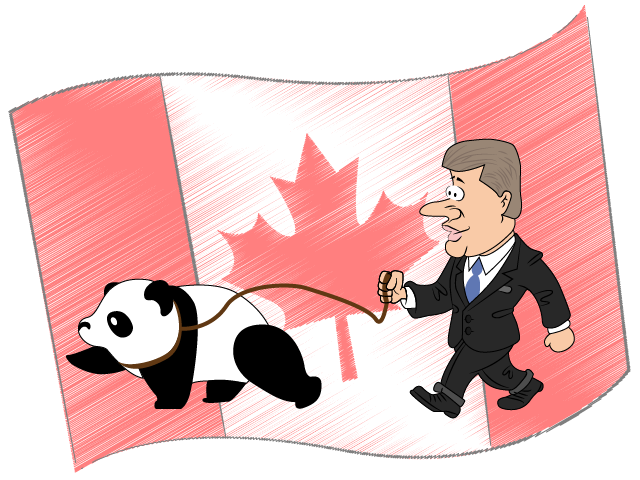
Who are they? They’re Er Shun and Da Mao, and you’ve undoubtedly heard about them by now. The two giant pandas recently touched down in Canada to much fanfare and celebration courtesy of the Chinese government for five year stays at both the Calgary and Toronto zoos. How are they important to Canadian-Chinese relations?
The two are destined to attract hoards of visitors and paying customers — that’s why we forked out over $1 million to bring them here. China and Canada can mutually benefit from reciprocal ties of friendship. We have much to learn from each other culturally and much to gain materially, but care needs to be taken. A panda can be stubborn and must be respectfully, yet firmly, worked with.
Take their diet: an unrelenting, monotonous supply of bamboo. This is the perfect metaphor for the insatiable Chinese economic need for natural resources and raw materials, and one we’ve done well to embrace. Ever since the financial crisis, Canada has increasingly cozied up to Beijing as national priorities have shifted from a mix of humanitarian concern and business ambition to pure economic overdrive. Bamboo, like the oil and other commodities we export to China, suits the pandas just fine. But just as zookeepers need to know when to say enough, so does the Canadian government need to critically evaluate just how far they’re willing to feed the Chinese, at what expense (remember Nexxen?) and how this influence can be used for further dealing with China on touchy subjects like human rights and democracy.
The handling of the cute mammalian duo also shows what the government shouldn’t do. Pandas are exotic star attractions and for good reason, but the zoos will never ignore their other charges for their sake. In fact, the regulars will continue to receive priority.
So maybe Harper shouldn’t have scheduled the pandas’ arrival and reception the same day the Nishiyuu walkers wound down their epic trek from James Bay, Que., to the nation’s capital to bring attention to the plight of indigenous peoples. The pandas may have flown 12,000 kilometres in 15 hours to come here (stocked with choice bamboo and veterinarians on standby) but the Nishiyuu walked 15,000 kilometres on their own two feet. For 68 days straight.
This is the first time in almost 25 years that we have pandas, an apt parallel to the once frosty relations between China and Canada that have thawed and, in some respects, blossomed. Yet just as Er Shun and Da Mao aren’t laurels to be rested on nor to be treated lightly, the time they’re on loan to us is the window we have for determining our future relationship with China. One of the aims of the zookeepers is to entice the duo into the panda’s notoriously difficult act of breeding. Yes, we have them for 10 years, but this means very little if we can’t get them to produce dividends: in their case cuddly pups, in China’s case strong and serious bonds between equals. In both cases an active and energetic approach is critical.
Panda diplomacy was once a bestowal of favour by Chinese dynasties to preferred foreign states on the periphery. While times have changed and China now finds itself amongst many equals, the act is undoubtedly one of honour. The Calgary and Toronto zoos have pulled off a coup by securing the pandas. By pursuing with acumen our current opportunities with China, Canada as a country should be able to do the same.



